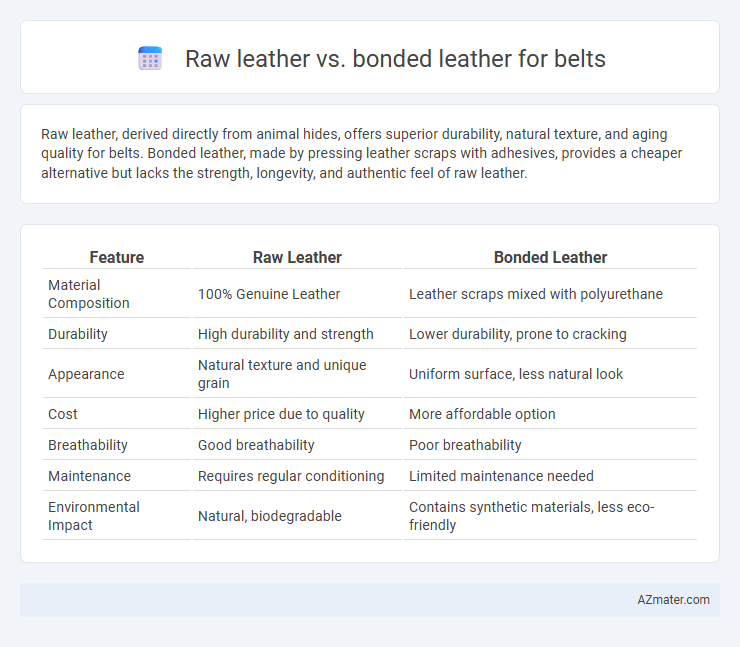Raw leather, derived directly from animal hides, offers superior durability, natural texture, and aging quality for belts. Bonded leather, made by pressing leather scraps with adhesives, provides a cheaper alternative but lacks the strength, longevity, and authentic feel of raw leather.
Table of Comparison
| Feature | Raw Leather | Bonded Leather |
|---|---|---|
| Material Composition | 100% Genuine Leather | Leather scraps mixed with polyurethane |
| Durability | High durability and strength | Lower durability, prone to cracking |
| Appearance | Natural texture and unique grain | Uniform surface, less natural look |
| Cost | Higher price due to quality | More affordable option |
| Breathability | Good breathability | Poor breathability |
| Maintenance | Requires regular conditioning | Limited maintenance needed |
| Environmental Impact | Natural, biodegradable | Contains synthetic materials, less eco-friendly |
Introduction to Raw Leather and Bonded Leather
Raw leather, derived directly from animal hides, offers natural durability, flexibility, and a unique texture prized in belt craftsmanship. Bonded leather, composed of leather scraps and fibers bonded with polyurethane or latex, provides a more affordable alternative but lacks the strength and longevity of genuine raw leather belts. Understanding these material differences helps consumers choose belts that balance aesthetics, durability, and budget preferences.
Defining Raw Leather: Characteristics and Types
Raw leather, often referred to as full-grain leather, retains the natural grain and surface imperfections, providing exceptional durability and a rich patina over time. Types of raw leather include full-grain and top-grain, each valued for their strength and breathability, making them ideal for high-quality belts. This material resists wear and develops a unique character with use, setting it apart from other leather types like bonded leather.
What is Bonded Leather? Composition and Features
Bonded leather is a composite material made by shredding genuine leather scraps and fibers, which are then bonded together with polyurethane or latex onto a fiber or paper backing. This engineered leather offers a consistent texture and appearance but lacks the durability and breathability of raw leather, making it more affordable yet less long-lasting for belts. Its surface can be embossed to mimic natural leather grain, providing an aesthetic option for budget-conscious consumers seeking leather-like products.
Durability Comparison: Raw Leather vs Bonded Leather
Raw leather belts exhibit superior durability due to their dense fiber structure and natural resistance to wear, maintaining strength and flexibility over time. Bonded leather belts, composed of leather scraps fused with adhesives, tend to degrade more quickly, showing peeling and cracking with prolonged use. The inherent quality of raw leather makes it a more reliable choice for long-lasting belt durability compared to the synthetic composition of bonded leather.
Appearance and Texture Differences
Raw leather belts exhibit a natural, rugged appearance with unique grain patterns and slight imperfections that enhance their authenticity and character. Bonded leather belts have a uniform, smooth surface due to the shredded leather fibers bonded with polyurethane, resulting in a more synthetic look and less breathable texture. The texture of raw leather is firm yet flexible, offering a rich tactile experience, while bonded leather feels smoother and often less durable, lacking the depth and warmth of genuine hide.
Cost Analysis: Price of Raw Leather vs Bonded Leather Belts
Raw leather belts typically cost significantly more than bonded leather belts due to the use of full-grain or top-grain leather, which requires extensive processing and higher quality hides. Bonded leather belts are more budget-friendly as they incorporate scraps and fibers mixed with a polyurethane or latex binder, resulting in lower production costs. Consumers seeking durability and long-term investment often prefer raw leather despite the higher price, while bonded leather appeals to cost-conscious buyers wanting a leather-like appearance at a reduced price.
Comfort and Wearability Factors
Raw leather belts offer superior breathability and softness, enhancing comfort during extended wear. Bonded leather belts, composed of leather scraps mixed with adhesives, tend to be less flexible and can cause stiffness, reducing overall wearability. Over time, raw leather develops a natural patina, improving comfort, while bonded leather often deteriorates quickly, leading to cracking and discomfort.
Environmental Impact and Sustainability
Raw leather, derived from untreated animal hides, has a significant environmental impact due to resource-intensive livestock farming and chemical tanning processes that generate hazardous waste. Bonded leather, made by combining leather scraps with synthetic materials and adhesives, reduces waste by repurposing leather remnants but often contains non-biodegradable components that hinder recyclability and contribute to microplastic pollution. Choosing raw leather with vegetable tanning methods or certified sustainable practices generally offers a more environmentally responsible option compared to bonded leather's mixed synthetic composition.
Maintenance and Care Requirements
Raw leather belts require minimal maintenance, needing only occasional conditioning with leather-specific oils to prevent drying and cracking, while ensuring they stay supple and durable. Bonded leather belts demand more frequent care, including gentle cleaning and conditioning to avoid peeling since they are composed of leather scraps bonded with adhesives. Proper storage away from direct sunlight and moisture is essential for both types to extend their lifespan and maintain appearance.
Which Leather is Best for Belts? Pros and Cons
Raw leather offers superior durability, natural texture, and ages gracefully, making it ideal for high-quality belts that last years. Bonded leather, made from leather scraps bonded with synthetic materials, is more affordable but less durable, often peeling or cracking with wear. Choosing raw leather belts provides long-term investment and classic appeal, while bonded leather suits budget-conscious buyers prioritizing style over longevity.

Infographic: Raw leather vs Bonded leather for Belt
 azmater.com
azmater.com